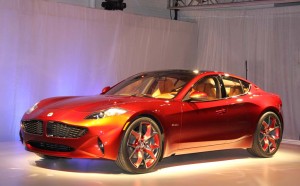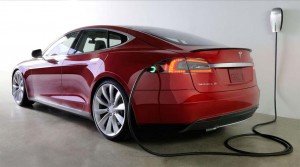California battery-car start-up Tesla Motors has shown it can take on established premium-luxury brands with its Model S sedan, but the real test will come when it launches an all-new mainstream electric vehicle it’s planning to call the Model 3, or Model III, depending on which tweet you read.
CEO and founder Elon Musk has long made clear his plans to go down-market, the new sedan expected to come somewhere around $35,000 – or between one-half and one-third of the price of the bigger Model S, depending on equipment and range. That would position the new offering as a direct competitor to the likes of – appropriately enough, the BMW 3-Series and Mercedes-Benz C-Class sedans.
The Model 3 actually would be Tesla’s fourth model, following the original Roadster, the Model S and the upcoming Model X sport-utility vehicle set to debut next year. But it would be, by Tesla’s count, bring the debut of the brand’s third-generation battery technology.
And it would allow the maker to come close to its original plans for a somewhat inside joke. The smaller model was originally scheduled to be called the Model E – until, that is, Tesla was reminded by rival Ford Motor Co. that the Michigan maker owned that trademark.
In one of his frequent Twitter posts, Musks noted he told a friend that since “we had the model S and X, we might as well have the E.” Then Ford stepped in, Musk explained, and “I thought this is crazy, Ford’s trying to kill sex! So we’ll have to think of another name.” And that’s why it’s going to be the Model 3, he went on, noting, “we’ll have three bars to represent it and it’ll be S III X!”
(“Lemon Law King” wins a round against Tesla. Click Here to find out how and why.)

Rival Fisker Automotive also wanted to go after a mainstream audience with its Atlantic plug-in model - until the company went bankrupt.
Whether buyers will be as passionate about the midrange model as Musk might be remains to be seen. While the Model S has been selling reasonably well in select, upscale markets, such as Beverly Hills and Silicon Valley’s Palo Alto, it still is generating demand for barely 3,000 vehicles per month, little more than an asterisk on the industry sales charts.
Indeed, battery cars, as a whole, including both plug-in hybrids and pure battery-electric vehicles, or BEVs, like the Model S, have so far captured a fraction of one percent of total U.S. sales. And conventional hybrids saw demand slide by nearly 10% during the first half of 2014.
Industry analysts such as Dave Sullivan, of AutoPacific, Inc., caution that existing mid-range models have been plagued by limited range and long charging cycles, mediocre performance, and hefty premiums for their battery powertrains.
(“Tuner” company Saleen is planning a high-performance version of the Tesla Model S. Click Herefor more.)
With the Model S – and for the upcoming Model X – Tesla has tried to overcome as many of those limitations as possible. The sedan, for one thing, can be ordered with an 85 kilowatt-hour battery that provides nearly 300 miles of range under optimum conditions. At the same time, the Model S can launch from 0 to 60 in barely 4 seconds, on a par with a Porsche 911. Using the most powerful home set-up, an owner can recharge in about 3 hours, while an expanding network of so-called Supercharger stations can yield an 80% “fill-up” in about 20 minutes.
Price is still an issue, and it remains to be seen where Tesla will have to cut back to meet the $35,000 target. At the current cost for lithium-ion batteries, an 85 kWh pack itself would cost the carmaker about that much.
But Musk has set a goal of slashing the cost of lithium-ion technology, and with partner Panasonic is getting ready to set up a so-called Gigafactory, a $5 billion battery plant that will be the biggest lithium cell production center in the world. The goal is to both increase production volumes and sharply drive down costs.
(Tesla wants to recover stolen, wrecked Model S. Click Here for the latest.)
The Model S has drawn strong praise, Consumer Reports, for one, declaring it the highest-scoring vehicle the magazine has ever tested. But it appeals to a rarified niche audience. Tesla has to rapidly expand its appeal if it is to consistently earn a profit – something it has only done through non-standard accounting practices.
Nonetheless, the maker has generated the sort of investor enthusiasm that more traditional automakers can only dream of, its stock hitting a $265.00 peak earlier this year. Shareholders had a cautious reaction to word of the Model 3 – or III – Tesla shares sliding just over 1% on Wednesday in the hours after the new model was confirmed.

